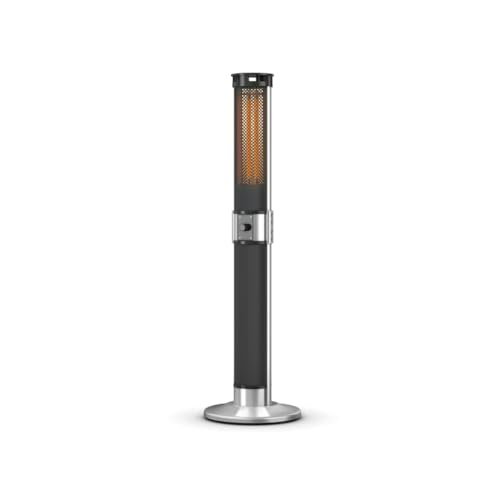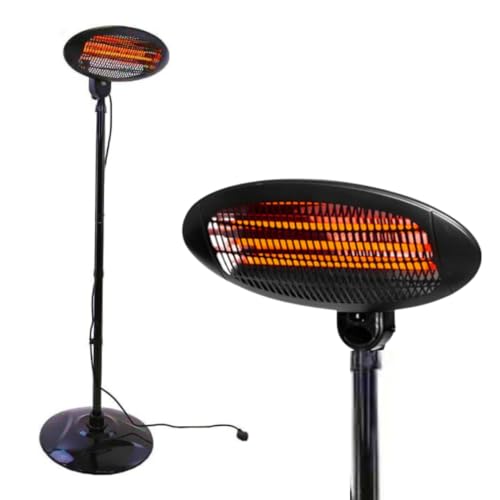Guide To Gas Patio Heater Small: The Intermediate Guide On Gas Patio H…
페이지 정보
작성자 Randal 작성일25-01-22 22:50 조회5회 댓글0건관련링크
본문
 Gas Patio Heater Small Gas Patio Heater
Gas Patio Heater Small Gas Patio Heater Restaurants use gas patio heaters, specifically tower-style floor models because they generate a lot heat, are affordable to operate, and can be spread in all directions. They require an connection to the natural gas line, and they can't be easily moved.
Restaurants use gas patio heaters, specifically tower-style floor models because they generate a lot heat, are affordable to operate, and can be spread in all directions. They require an connection to the natural gas line, and they can't be easily moved.The propane-powered model is lightweight and wind-resistant enough to keep you warm in a chilly evening. It has a high output of heat and is easy to set up, but the assembly took a bit of time.
Features
Patio heaters are a great way to enhance the comfort of outdoor dining or entertainment whether you're entertaining friends or having an intimate meal. A variety of models are designed to work in different environments, so you can keep the party going well late into the evening. They are typically powered by propane or electricity and are available in freestanding and tabletop models, as being wall-mounted versions.
It is important to consider the power rating when selecting the propane model. This number, which is measured in BTUs, reflects the amount of heat it produces and how far that warmth will travel. Schimmenti suggests multiplying the square footage by 20 to determine the BTUs needed to heat the space.
Propane heaters are portable and simple to refill, but you'll need to keep a supply of fuel on hand. There are models with a caster base that allows for mobility over paved surfaces, or an anti-tilt switch that stops the heater in the event that it's tilted, or tilted over.
A gas heater that is freestanding has an igniter that burns natural gas, propane, liquefied petroleum gas (LPG) propane, or butane. It is directed by the flames to an aluminum screen perforated to produce heat. The heat is radiated in a circular pattern around the heater and a reflector at the top of it helps prevent convection and loss of heat.
Electric radiant patio heaters are a different option. They are heated by emitting infrared radiation that warm the objects and those around them. They are usually cheaper to run than propane models and may be more practical if you have a limited number of electrical outlets in your small patio gas. The heat they generate may not be as effective in cold temperatures, and will evaporate faster than propane heaters.
If you are concerned about the impact of outdoor heating on the environment, you can connect natural gas patio heaters to your home's gas line for cleaner burning. While they're more expensive to run, you can save money over time by not needing to purchase or refill propane tanks.
Design
When it comes to enhancing an outdoor commercial or residential space gas patio heaters blend functionality and style. They can be fueled by electricity, propane gas or natural gas, based on your location and heating needs. They come in a variety of sizes and styles. They provide warmth via radiant heat or direct flame. Some are also wind-resistant, making them ideal for outdoor spaces that may be prone to soaring breezes.
The Right Size Heater
A gas patio heater near me patio heater mounted over a large outdoor space is the ideal choice. These heaters are positioned on ceilings or walls and use infrared radiation to send heat downwards. This kind of heater is highly efficient and efficient, warming people and objects directly instead of simply heating the air around them. It's also more appealing visually than freestanding types that can take up valuable space on tables or chairs.
If you're looking to save on costs and maintenance opt for an engine powered model that runs on propane. These models are smaller and run on portable propane tanks, which can be easily removed when they're full. They will need to be refilled regularly and will not perform as well as a gas or natural-powered model.
Another option that is popular is a tabletop gas patio heater which offers warmth for tables and seating areas, without taking up the floor space. These heaters are usually constructed of a glass tube that houses propane fuel and an electric burner on top. These heaters are distinguished by their dome-shaped tops that help direct heat towards the middle of the table. Other features include wheels for effortless movement and a safety shut-off in case the heater tips over and an anti-slant design. Some of these heaters feature a hammered bronze resin wicker or decorative stone faces that can add to the look of your space. These units are ideal for bars, restaurants and other businesses that want to extend outdoor dining area and seating into the cooler seasons.
Safety
A patio heater can be used to keep you warm and comfortable in cooler temperatures than what you'd experience inside your home. If you're looking for one, it's important to think about the dimensions of your space as well as the amount of people you plan on using it with to ensure you get an appliance that has the proper heat output. Some patio heaters are also equipped with safety features.
If you are considering a propane or natural gas patio heater, you'll need to consider the BTUs it generates. The higher the BTUs the more powerful the heater. According to Better Homes & Gardens, the average outdoor patio heater can generate around 40,000 BTUs of heat. To ensure that you buy an outdoor heater that has enough heat, multiply the area of your outdoor patio by 20.
When you are shopping for a patio heater, be aware of the design and construction. A durable model built to withstand extreme conditions will last longer. A heater with wheels makes it easy to move the heater into position when required. Some models even come with straps that allow you to attach the propane tank for additional stability.
A propane patio heater generates heat by vaporizing the liquid propane. The propane is then passed through tubes. A glass shield is typically placed over the flame of the burner in order to reduce the risk of fire and protect it. A lot of patio heaters designed for residential use feature an automatic shut-off feature that shuts off the burner after a set period of time, meaning you don't have to shut it off by yourself.
It's crucial to ensure that you provide your gas patio heater plenty of room for proper air circulation. If you don't, carbon monoxide as well as the gas nitric oxide could build up in your home. These gases are known to cause drowsiness, and even death in extreme circumstances. To avoid risk, make sure that your patio heater is enclosed by at least three feet. You should also keep it away from furniture, walls and other materials that can ignite.
The Performance of a
Gas patio heaters are a great addition to outdoor areas that allow guests to enjoy warm evenings in the cozy confines of their home. These heaters are usually powered by propane, natural gas or electricity and produce various amounts of heat. Consider the total heat output, operating costs, and fuel source of each model to decide which one is Best patio heater gas for your requirements and budget.
Some models come with wheels that allow you to move them around a patio, deck or any other outdoor space. Some also include a heavy base for stability, or an anti-tilt device that stops the unit from tumbling over. Find a patio heater that offers an electric shut-off in order to prevent burning when the flame is out and features like a hammered bronze, resin wicker or decorative stone faces for a more appealing appearance.
The heat generated by patio heaters is measured in BTUs or British Thermal Units. The greater the BTU rating of a patio heater, the more heat it will generate. A gas patio heater with higher BTU ratings is typically more expensive to run than an electric model but it will also provide more warmth. Take into consideration the size of your space and the climate of your area when determining the amount of heat required to keep your guests comfortable.
Overhead gas patio heaters, such as the Bromic Tungsten Smart Heat Gas Patio Heater, can provide the highest heat output in modern, sleek design. In contrast to traditional patio heaters that heat the air, these units utilize sophisticated infrared technology that warms objects and people directly. This helps reduce energy consumption and removes cold spots in large outdoor commercial or residential settings.
Overhead heaters are also a good option in windy conditions. Their design permits them to direct heat directly to the places where it is needed.
The Calcana High Output Stainless Steel Gas Patio Heater with Temperature Control is an ideal option for commercial venues that rely on outdoor heating to enhance the use of their indoor and outdoor dining and entertainment areas. This model can effectively heat large outdoor spaces and is operated remotely. Its robust design is built to withstand the pressures placed on it by busy commercial environments. It is also simple to operate for staff.
Warning: Use of undefined constant php - assumed 'php' (this will throw an Error in a future version of PHP) in /data/www/kacu.hbni.co.kr/dev/skin/board/basic/view.skin.php on line 152
댓글목록
등록된 댓글이 없습니다.

